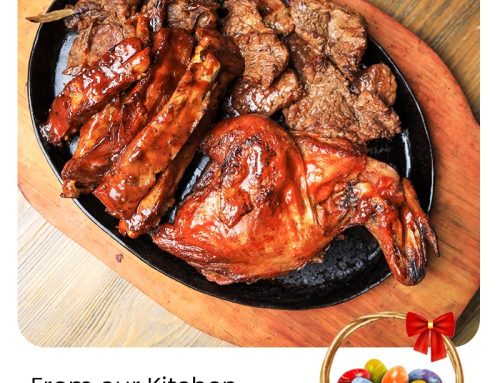Flowers for Food?
Valentines Day at the GMC Place in Kitengela was a great opportunity to share the great cuisine at the hub for fun. But apart from the food and fun, there was an extra surprise for the lovers attending either the Couples Fantasy galore every Wednesday since February or those enjoying the benefits of Valentines.
In both cases there was a rose flower to be received by each lady in the house! Shortly after the embers of Valentine’s Day had settled, GMC Place was at it again. This time engaging flower lovers and leading from the front with regard to flower planting!
Unique in every way, it was the first time many were hearing about the challenge and some also participated making the fun merrier for being more. After the launch a series of questions from participants raised a key question – are flowers food? If yes, can they be eaten?

Floral centerpieces on the dinner table are a classic and timeless tradition, but flowers can sometimes show up on your dinner plate, too. Edible flowers are used in many different styles of cuisine and can be found on menus all over the world. While not all flowers are safe to eat, there are those that can offer a unique burst of flavor and color to many dishes, including salads, sauces, beverages and entrées. Some of them may even offer health benefits.
At the expansive gardens of GMC Place, it is not hard to spot the Hibiscus with it’s peach and orange blossoms. The Hibiscus plants produce large, ornate blossoms that usually grow in tropical and subtropical climates around the world. Hundreds of hibiscus species exist, but the most popular edible variety is known as roselle or Hibiscus sabdariffa.

Hibiscus flowers can grow as large as 6 inches (15 cm) in diameter and are found in a wide array of colors — including red, white, yellow and various shades of pink. Although sometimes grown for strictly ornamental purposes, hibiscus is also well known for its culinary and medicinal applications. You can eat the flower straight from the plant, but it is usually used for tea, relishes, jam or salads. Many cultures drink hibiscus tea for its medicinal properties. Some studies indicate that hibiscus may help reduce blood pressure and cholesterol levels.
Dandelions are best known as stubborn garden weeds. However, they happen to double as a highly nutritious edible flower. Dandelions have small blossoms — roughly 2–4 cm in diameter — with many tiny, bright-yellow petals. They supply various plant compounds known to have powerful antioxidant properties. Interestingly, the flowers are not the only part of dandelion that can be eaten.
In fact, every part of this so-called weed can be enjoyed — including its roots, stems and leaves. There are endless options for eating dandelion. The flowers can be eaten raw, either alone or tossed into a salad. They may be breaded and fried or used to make jelly and wine. The roots are often steeped to make tea, while the greens may be consumed raw as a salad or a sandwich topping. They can also be cooked in stews, casseroles or any other dish that calls for hearty greens.

Lavender is a woody, floral herb originally grown in parts of northern Africa and the Mediterranean. The violet flowers are very small but plentiful. Lavender is probably best known for its distinctive fragrance, which is acclaimed for its calming effects.
The combination of color and aroma make lavender a particularly desirable addition to a variety of foods, including baked goods, infused syrups, liqueurs, herbal teas, dry spice rubs and herb mixtures. Its flavor pairs well with both sweet and savory ingredients, including citrus, berries, rosemary, sage, thyme and chocolate.
Almost 200 honeysuckle species exist, but the most common are the Japanese and woodbine varieties. The fragrant blossoms, typically light yellow or white, hold nectar that can be eaten straight from the flower. Honeysuckle has been vital to traditional Chinese medicine practices for centuries.
The flowers and their extracts are ingested or applied to the skin to treat various inflammatory conditions. However, its efficacy as medicinal therapy for humans remains scientifically unproven. In the culinary world, honeysuckle is most often used to make tea or a fragrant, flavorful syrup. You can use the syrup to sweeten iced tea, lemonade, yogurt and sorbet or as a sugar replacement in quick bread recipes.

Nasturtium is a culinary favorite because of its brightly colored blossoms and unique, savory flavor. Both the leaves and flowers of nasturtium are edible and may be enjoyed cooked or raw. They feature a peppery, slightly spicy flavor profile, although the blossoms themselves are milder than the leaves.
The funnel-shaped flowers are typically bright orange, red or yellow. They make a beautiful garnish for cakes, pastries and salads. The leaves are round and resemble small lily pads. They’re tender enough to be used as salad greens or blended into pesto.
Nasturtium is not only a versatile and eye-catching ingredient but also nutritious — containing a variety of minerals and health-promoting compounds with antioxidant and anti-inflammatory effects. Borage, or starflower, is an herb that produces delicate, star-shaped flowers. The blossoms are usually blue but may also be white or pink. In herbal medicine, borage is used to treat minor ailments, such as sore throat or cough.
However, human research to support its efficacy as a medical therapy is scarce. In the kitchen, there is no shortage of ways to put borage to use, as both the flowers and leaves are edible. The flowers are often described as having a slightly sweet flavor that is reminiscent of cucumber and honey. The flowers may be eaten fresh in a salad or as a garnish for desserts and cocktails — or they may be cooked and added to soups, sauces or stuffed pasta fillings. Borage can also be served as a stand-alone vegetable side dish.
Purslane is a succulent that produces tiny, yellow flowers and thick, fleshy leaves — both of which are edible and may be eaten cooked or raw. Historically, purslane was considered no more valuable than a garden weed. However, this little plant has recently soared in popularity due to its rich nutrient content.
It’s filled with vitamins, minerals and antioxidants, but its biggest claim to nutritional fame is its omega-3 fat content. In fact, purslane provides more omega-3s than almost any other vegetable of its kind. The flowers and leaves of purslane can be served raw in many salads and sandwiches. They may also be sautéed or steamed with other vegetables as a side dish or added to your favorite soups. You may even consider trying this plant battered and fried.
There are over 150 species of roses available in almost any imaginable size and color. The best part is that they’re all edible. However, roses don’t all taste the same. A good rule of thumb for choosing a flavorful rose is that if it smells pleasant, it’ll probably taste good, too.
Only eat the petals, though, because the leaves and stems don’t make a very palatable snack. Roses petals have a very aromatic, floral and slightly sweet flavor. They can be eaten raw, mixed into various fruit or green salads or dried and added to granola or mixed herbs. Fresh rose petals can also be muddled and added to liquid to create rose-infused beverages, jams and jellies. Chopped rose petals added to sugar or butter give a unique zing to otherwise ordinary ingredients.
If you’ve ever grown summer squash in your garden, you’re probably aware of their delicate flowers. However, you may not know that these flowers are just as edible as the squash itself. Although these blossoms form on all types of summer squash, the most popular come from zucchini.
Zucchini flowers are bright yellow with a long, rounded bell shape. These flowers can be eaten raw as a garnish or chopped and added to salads. If you’re feeling indulgent, another delicious option is to stuff the blossoms with herbed cheeses and fry or bake them until the delicate petals become crispy.
Chamomile is a floral herb used in cooking and traditional medicine for centuries. Medicinally, chamomile is often consumed to reduce anxiety and improve sleep quality. The flowers closely resemble daisies, albeit much smaller. They lend a slightly sweet, earthy flavor to the foods they’re cooked with.
Most recipes call for heating the flowers in a liquid to extract their flavors and bioactive compounds. The leaves and flowers are usually dried first but can be used fresh. While most often utilized for chamomile tea, the blossoms can also make syrups or other infusions for baked goods, smoothies or desserts.
In conclusion, although you may be accustomed to seeing flowers only as decoration, or in the different corners and pathways at GMC Place, you can add many of them to your diet for a pop of color and texture. Additionally, many edible flowers are nutritious and contain potent antioxidants and anti-inflammatory compounds that can support your health.
You can serve them raw, cook them with vegetables, fry them as a snack or sprinkle them on your desserts. So today, choose to plant a flower. Not only will it make the ground more beautiful, but it will definitely make the world a better place.
Visit us Today in Kitengela or Contact us at
Tel: +254 701 560560
Email: info@funplace.co.ke





